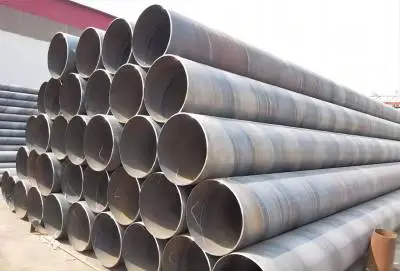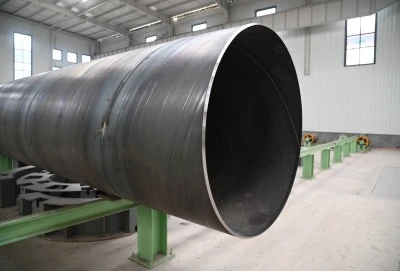1. Material Preparation:
The production of helical welded pipes begins with the selection and preparation of the steel coils that will be used as the raw material. These coils must meet specific material specifications, such as chemical composition, tensile strength, and dimensional tolerances, to ensure the final product meets the required standards and performance criteria.
The steel coil selection process involves careful inspection and testing to verify the material's quality and suitability for the intended application. This may include analyzing the coil's chemical composition, checking the thickness and width, and performing mechanical tests to assess the steel's strength and formability.
Once the appropriate steel coils have been identified, they are carefully handled and transported to the manufacturing facility, where they will undergo the subsequent steps in the helical welded pipe production process.
|
|
|
2. Uncoiling:
The first step in the helical welded pipe manufacturing process is the uncoiling of the steel coil. This involves feeding the coil into a specialized machine that gradually unrolls the steel strip, transforming it from a coiled state into a straight, continuous length of material.
The uncoiling process is designed to minimize any potential damage or deformation to the steel strip, ensuring that the material retains its structural integrity and dimensional accuracy. This is crucial, as any irregularities or defects in the steel strip can be carried through to the final product, potentially compromising the pipe's performance and reliability.
After the uncoiling is complete, the straight steel strip is then ready to enter the next stage of the helical welded pipe manufacturing process.
3. Forming:
The forming stage of the helical welded pipe production process involves shaping the straight steel strip into a spiral or helical configuration. This is typically accomplished using a specialized forming machine that applies a combination of bending, rolling, and shaping forces to the steel strip.
The precise control of the forming parameters, such as the bending radius, the angle of the spiral, and the speed of the process, is critical in ensuring the desired shape and dimensional accuracy of the helical pipe. Any deviations from the optimal forming conditions can result in variations in the pipe's diameter, wall thickness, or overall geometry, which can impact its functionality and performance.
As the steel strip is formed into the helical shape, it is important to monitor the process closely and make any necessary adjustments to maintain the integrity of the material and the consistency of the final product.
4. Helical Welding:
Following the forming stage, the next critical step in the production of helical welded pipes is the welding process. This involves joining the adjacent edges of the spirally-shaped steel strip to create a continuous, seamless pipe structure.
The most common welding method used in the production of helical welded pipe is the high-frequency electric resistance welding (HF-ERW) process. This technique uses a high-frequency electrical current to heat and fuse the steel edges, creating a strong, uniform weld that runs along the length of the pipe.
Maintaining precise control over the welding parameters, such as the current, voltage, and welding speed, is essential to ensuring the integrity and quality of the weld. Continuous monitoring and adjustment of these parameters are necessary to prevent defects, such as incomplete fusion, excessive heat input, or weld-related distortion.
By optimizing the helical welding process, manufacturers can produce high-quality, durable helical welded pipes that meet the required standards and specifications.
5. Sizing and Shaping:
Following the helical welding process, which involves joining two sheets of metal at an angle around their circumference to form a tube, the resulting product moves onto the sizing and shaping stage. This crucial phase focuses on ensuring that the pipe meets precise dimensional specifications.
In this process, the pipes are passed through specialized machinery capable of applying hydraulic or mechanical pressure according to predetermined dimensions. The size is adjusted based on factors such as diameter, wall thickness, and length requirements specific to their intended application.
The shaping may involve cold drawing techniques where the pipe is pulled through a die that has the required internal diameter, reducing its wall thickness while maintaining its overall size. Alternatively, warm or hot rolling processes might be used for large diameter pipes, where they are passed through rolls at high temperatures to reduce dimensions and refine the shape.
In both cases, after sizing and shaping, quality checks are performed to ensure compliance with manufacturing standards and customer specifications. This could include tests for dimensional accuracy, surface finish, mechanical properties like tensile strength and yield point, as well as specific industry requirements such as pressure ratings or corrosion resistance.
The outcome of this stage is a precisely manufactured helical welded pipe ready for use in various industries including but not limited to oil & gas, construction, water supply systems, petrochemicals, and more, where reliability and durability are paramount.
The sizing and shaping process typically includes the use of calibration rollers, mandrels, and other forming tools to ensure the pipe meets the desired dimensional requirements. These tools apply targeted forces and pressures to the welded pipe, carefully adjusting its shape and size to the specified tolerances.
In addition to the dimensional control, this stage may also involve additional surface treatments, such as descaling, deburring, or coating, to enhance the pipe's appearance, corrosion resistance, or other performance characteristics. The specific post-processing steps will depend on the intended application and the customer's requirements.
By carefully managing the sizing and shaping process, manufacturers can produce helical welded pipes that consistently meet the high standards of quality and performance expected in various industrial and infrastructure applications.
6. China Helical Welded pipe factory:
Longma, a leading manufacturer of steel pipes in China, offers a comprehensive range of helical welded pipe products that meet a variety of industry standards, including API 5L, ASTM A53, ASTM A500, ASTM A252, and ASTM A795.
Longma's state-of-the-art manufacturing facilities and advanced production techniques allow them to produce high-quality helical welded pipes with exceptional dimensional accuracy and structural integrity. Their commitment to quality is evident in their strict adherence to industry standards and their comprehensive quality control measures, which include extensive testing and inspection at every stage of the manufacturing process.
Whether you require helical welded pipe for oil and gas transportation, water supply systems, or other industrial applications, Longma's experienced team can work with you to identify the most suitable pipe solutions to meet your specific requirements. Customers interested in Longma's helical welded pipe offerings are encouraged to contact them at info@longma-group.com for more information.














